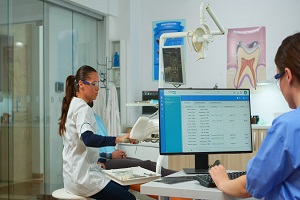The following Recognizing and Reporting Child Abuse and the Neglect Training course educates dental healthcare providers (DHCP) on how to keep children safe.
What You’ll Learn
- What Is Child Abuse and Neglect?
- Types of Child Abuse and Neglect
- Signs of Abuse
- Mandated reporting guidelines
Details
Course length: 60 minutes; CEU: 1.00
Languages: American English
Key features: Audio narration, learning activity and post-assessment
Get Certified
American Medical Compliance (AMC) is a leader in the industry for compliance, Billing and HR solutions. To become certified, please visit us at American Medical Compliance (AMC).
Reach out for other courses by visiting the AMC Course Library.
Child Abuse and Neglect
Child abuse and neglect can come in many forms, such as physical abuse. Physical abuse describes a non-accidental injury to a child caused by a person responsible for the child. Types of physical abuse include punching, beating, and kicking.
Course-takers study the difference between physical discipline and abuse. Physical abuse ranges from minor bruises to severe fractures, and can even be deadly in some cases. Moreover, learners must possess situational awareness to spot signs of physical abuse and other forms of neglect in order to protect children.
Sexual Abuse and Other Forms of Neglect
Several activities are forms of sexual abuse. Sexual abuse includes inappropriate touching and sexual conduct. However, children may also face emotional or psychological abuse. Emotional abuse describes a caregiver’s behavior that impairs a child’s emotional development or sense of self-worth. Emotional abuse takes several forms and is difficult to prove. As a result, child protective services often struggle to intervene. Other types of abuse that a child might be subject to include abandonment or neglect. When a child is abandoned by a caregiver, they are more likely to incur serious harm or threats to their health and safety. Children need adequate support to develop fully, and a lack of parental presence can have detrimental impacts on child outcomes.
Signs of Child Abuse
There are often several signs of physical abuse that victims exhibit. Here are a few of them:
Unexplained injuries are a common sign of abuse. These could include burns, bites, or bruises. Additionally, if you notice that the child has fading bruises or other noticeable marks after a period of time since their last visit, this could indicate abuse. Children may also seem scared, anxious, or depressed.
A big tell-tale sign of abuse is if the child seems frightened of their parents and protests leaving with them. They might be scared of adults in general.
Children may also exhibit other physiological signs if they are abused. These could include changes in eating or sleeping habits. Most importantly, listen to a child if they report that they are abused. Pay attention to parents’ behaviors, and watch out for aggressive tendencies. Many times, abusers will try to explain away injuries, so it is important to remain vigilant in protecting the child.
Signs of Sexual Abuse
There are several signs that a child may be a victim of sexual abuse. Physical ailments are common, such as difficulty walking, bleeding, or bedwetting.
Additionally, the child may become isolated and withdrawn. Alternatively, they may experience a sudden change in appetite. A major red flag is if a child has inappropriately advanced knowledge of sexual behaviors.
Reporting Abuse Properly
The Recognizing and Reporting Child Abuse and Neglect Training enhances patient safety outcomes by educating learners on proper reporting procedures in child abuse and neglect cases. The course is highly interactive and engaging and can be done in your preferred setting and pace. You may access interactive bite-sized episodes that are intended to be watched using any device you prefer.
This particular course helps dental healthcare personnel understand the proper standards for making a report of abuse or neglect. Moreover, this course discusses how to recognize the signs of abuse in a child. It is crucial that by the end of the Recognizing and Reporting Child Abuse and Neglect course, the participants have an in-depth understanding of their role in protecting children from abuse and neglect.
Making a Report
The written report must include the name and contact information of the person making the report. This is referred to as disclosure of reporter identity. The subject of the report will receive the report with confidentiality maintained.
The identity of the person making the report will not be revealed to the subject of the report. Furthermore, the contents of the report will only be shared with appropriate and necessary individuals.
Reports may be made available to parents or guardians of the child named in the report. Complete this training to learn the required elements that your report must include.
Helping Victims By Reporting
Take the situation seriously if a child tells you they are being abused. We must protect the safety of children first. The training includes tips for steps that reporters can make. For example, it can be helpful to encourage the child to talk about what happened. By assuring them that they are in a safe space, children will feel more comfortable talking about their experiences.
Online Recognizing and Reporting Child Abuse and Neglect Training
A published study (Roberts, 2022) revealed that interactive techniques such as the use of videos, group discussions, and the use of real-world examples were more effective training strategies. They all stood out and were easily remembered by the participants. This contributes to the awareness of what training design and delivery work best for future training.



